Study notes for Trees
By BYJU'S Exam Prep
Updated on: September 25th, 2023

A tree is a non-linear and hierarchical Data Structure.
Trees represent data containing a hierarchical relationship between elements e. g., records, family trees and table contents. A tree is a data structure based on a hierarchical tree structure with a set of nodes.
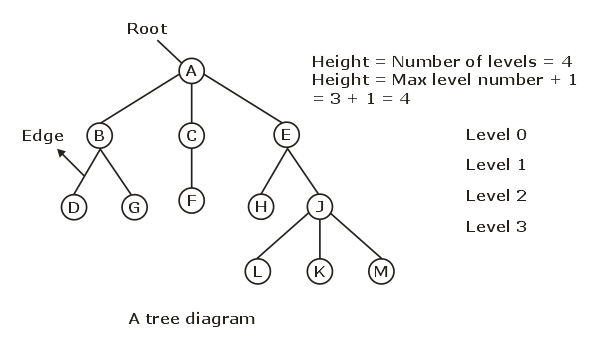
-
Trees can be used
- for underlying structure in decision-making algorithms
- to represent Heaps (Priority Queues)
- to represent B-Trees (fast access to the database)
- for storing hierarchies in organizations
- for file system
Binary Tree
A binary tree is a tree-like structure that is rooted and in which each node has at most two children, and each child of a node is designated as its left or right child. In this kind of tree, the maximum degree of any node is at most 2. A binary tree T is defined as a finite set of elements such that
- T is empty (called NULL tree or empty tree).
- T contains a distinguished Node R called the root of T, and the remaining nodes of T form an ordered pair of disjoint binary trees T1 and T2.
- Node: Each data item in a tree.
- Root: First or top data item in a hierarchical arrangement.
- Degree of a Node: Number of subtrees of a given node.Example: Degree of A = 3, Degree of E = 2
- Degree of a Tree: Maximum degree of a node in a tree.Example: Degree of above tree = 3
- Depth or Height: Maximum level number of a node + 1(i.e., level number of a farthest leaf node of a tree + 1).Example: Depth of above tree = 3 + 1= 4
- Non-terminal Node: Any node except root node whose degree is not zero.
- Forest: Set of disjoint trees.
- Siblings: D and G are siblings of parent Node B.
- Path: Sequence of consecutive edges from the source node to the destination node.
- Internal nodes: All nodes that have children nodes are called internal nodes.
- Leaf nodes: Those nodes, which have no child, are called leaf nodes.
- The depth of a node is the number of edges from the root to the node.
- The height of a node is the number of edges from the node to the deepest leaf.
- The height of a tree is the height of the root.
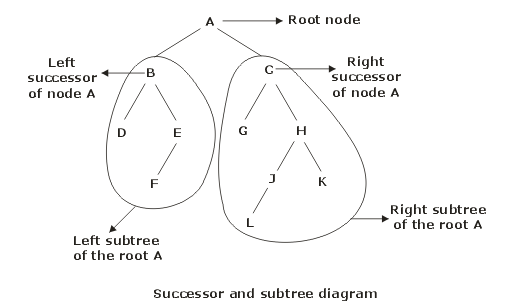
Any node N in a binary tree T has either 0, 1 or 2 successors. Level l of a binary tree T can have at most 2l nodes. The number of nodes on each level i of binary tree is at most 2i
- The number n of nodes in a binary tree of height h is at least n = h + 1 and at most n = 2h+1 – 1, where h is the depth of the tree.
- Depth d of a binary tree with n nodes >= floor(log n)
- d = floor(log N); lower bound, when a tree is a full binary tree
- d = n – 1; upper bound, when a tree is a degenerate tree
Creation of a binary tree
void insert(node ** tree, int val) {
node *temp = NULL;
if(!(*tree)) {
temp = (node *)malloc(sizeof(node));
temp->left = temp->right = NULL;
temp->data = val;
*tree = temp;
return;
}
if(val < (*tree)->data) {
insert(&(*tree)->left, val);
}
else if(val > (*tree)->data) {
insert(&(*tree)->right, val);
}
}
Search an element into binary tree
node* search(node ** tree, int val) {
if(!(*tree)) {
return NULL;
}
if(val == (*tree)->data) {
return *tree;
}
else if(val < (*tree)->data) {
search(&((*tree)->left), val);
}
else if(val > (*tree)->data){
search(&((*tree)->right), val);
}
}
Delete an element from binary tree
void deltree(node * tree) {
if (tree) {
deltree(tree->left);
deltree(tree->right);
free(tree);
}
}
Strictly Binary Trees
If every non-terminal node in a binary tree consists of non-empty left subtree and right subtree. In other words, if any node of a binary tree has either 0 or 2 child nodes, then such tree is known as strictly binary tree or extended binary tree or 2- tree. Complete Binary Tree: A complete binary tree is a tree in which every level, except possibly the last, is filled. A complete binary tree has the following properties
- Which can have 0, 1 or 2 children.
- First, we need to fill the left node, then the right node in a level.
- We can start putting data items in the next level only when the previous level is filled.
- A complete binary tree of the height h has between 2h and 2(h+1)-1 nodes.
Tree Traversal: Three types of tree traversal are given below
Preorder
- Process the root R.
- Traverse the left subtree of R in preorder.
- Traverse the right subtree of R in preorder.
/* Recursive function to print the elements of a binary tree with preorder traversal*/
void preorder(struct btreenode *node)
{
if (node != NULL)
{
printf(\%d, node->data);
preorder(node->left);
preorder(node->right);
}
}
Inorder
- Traverse the left subtree of R in inorder.
- Process the root R.
- Traverse the right subtree of R in inorder.
/* Recursive function to print the elements of a binary tree with inorder traversal*/
void inorder(struct btreenode *node)
{
if (node != NULL)
{
inorder(node->left);
printf(\%d, node->data);
inorder(node->right);
}
}
Postorder
- Traverse the left subtree of R in postorder.
- Traverse the right subtree of R in postorder.
- Process the root R.
/* Recursive function to print the elements of a binary tree with postorder traversal*/
void postorder(struct btreenode *node)
{
if (node != NULL)
{
postorder(node->left);
postorder(node->right);
printf(\%d, node->data);
}
}
Breadth First Traversal (BFT): The breadth-first traversal of a tree visits the nodes in the order of their depth in the tree. BFT first visits all the nodes at depth zero (i.e., root), then all the nodes at depth 1 and so on. At each depth, the nodes are visited from left to right.
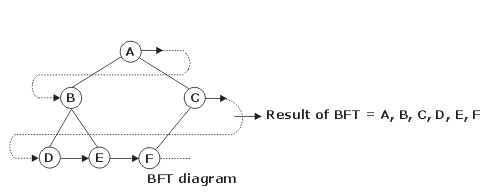
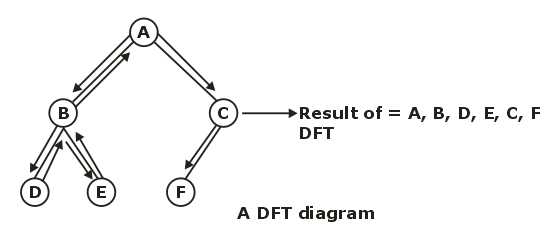
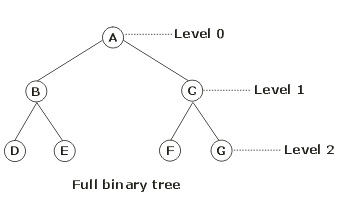
All leaves (D, E, F, G) are at depth 3 or 2, and every parent has exactly 2 children. Let a binary tree contain MAX, the maximum number of nodes possible for its height h. Then h= log(MAX + 1) –1.
The height of the Binary Search Tree equals the number of links of the path from the root node to the deepest node.
- Number of internal/leaf nodes in a full binary tree of height h2h leaves
- 2h -1 internal nodes
Expression Tree
An expression tree is a binary tree that represents a binary arithmetic expression. All internal nodes in the expression tree are operators, and leaf nodes are the operands. The expression tree will help in the precedence relation of operators. (2+3)*4 and 2+(3*4) expressions will have different expression trees.
Example1: Recursive function for size (number of nodes) of a binary tree
int size(struct btreenode *node)
{
if (node == NULL)
return 0;
else
return (1 + size(node->left) + size(node->right));
}
Example2: Recursive function for Height of a tree
(Hieght is the length of path to the deepest node from the root node of tree)
int height(struct btreenode *node)
{
if (node == NULL) return 0;
else return (1 + Max(height(node->left), height(node->right)));
}
Example3: Print the elements of binary tree using level order traversal
void levelorder(struct node* root)
{
int rear, front;
struct node **queue = createqueue(&front, &rear);
struct node *tempnode = root;
while (temp_node)
{
printf(\%d , tempnode->data);
if (tempnode->left)
enqueue(queue, &rear, tempnode->left);
if (tempnode->right)
enqueue(queue, &rear, tempnode->right);
tempnode = dequeue(queue, &front);
}
}
struct node** createqueue(int *front, int *rear)
{
struct node **queue = (struct node **) malloc(sizeof(struct node*)*n);
*front = *rear = 0;
return queue;
}
You can practice 110+ Mock Tests for Exams like GATE, NIELIT, BARC, ISRO with BYJU’S Exam Prep Test Series
Click Here Avail Computer Science Engineering Test Series (112+ Mock Tests)
You can follow the Computer Science Champion Study Plan:
Detailed schedule for GATE CSE Champion Study Plan
Thanks
#DreamStrtiveSucceed
The Most Comprehensive Exam Prep App


